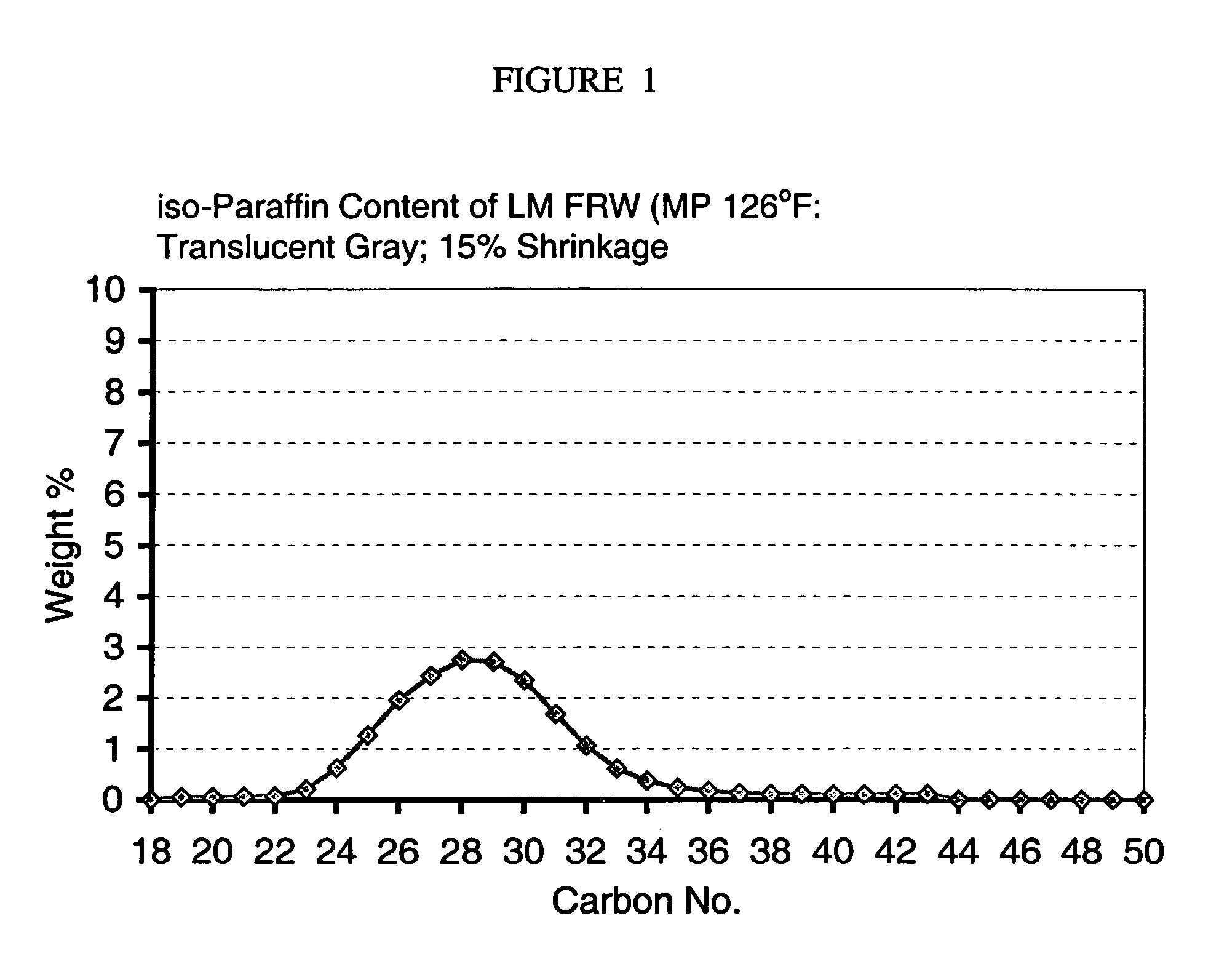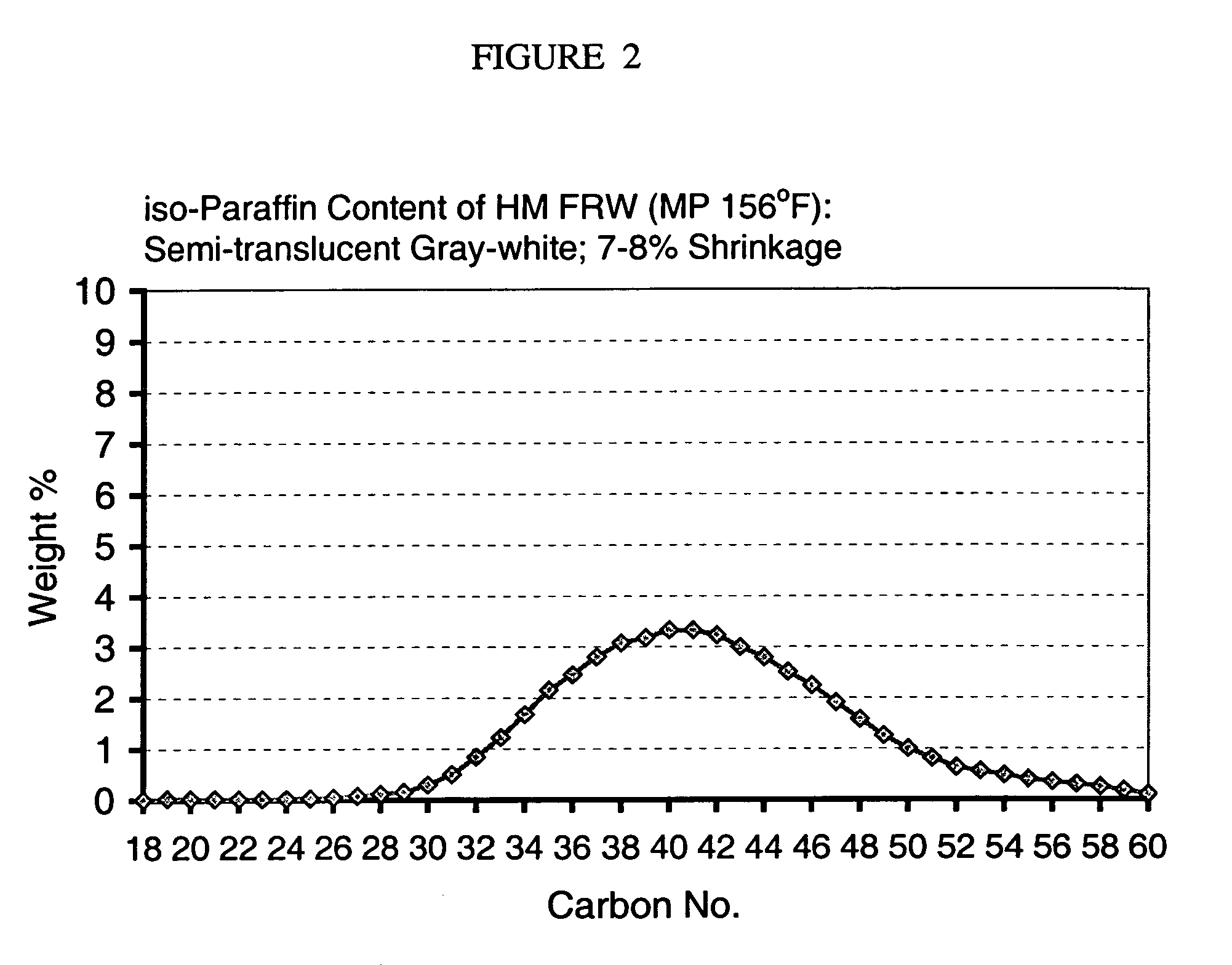Wax blends for candles with improved properties
a technology of wax and blends, applied in the direction of candles, candle ingredients, fuels, etc., can solve the problems of excessive shrinkage, poor fragrance retention, and certain problems in candle production, and achieve the effects of low oil bleed, low shrinkage, and good color and textur
- Summary
- Abstract
- Description
- Claims
- Application Information
AI Technical Summary
Benefits of technology
Problems solved by technology
Method used
Image
Examples
example 1
[0054]Hoping to take advantage of the low shrinkage and opaque white color characteristics of the MM RHC™ wax, while maintaining the low oil bleed and fragrance hold characteristics of the FRW, the inventors experimented with blends of the commercially available LM FRW 126, HM FRW 156 and MM RHC™ 135. The blends were selected to maintain a commercially viable final melting point and cost. Initial attempts to blend only a LM FRW wax and the MM RHC™ proved unsuccessful in controlling the oil bleed of the final blend. The inventors added a minor amount of a HM FRW 156 to the blends in an attempt to control the oil bleed by providing higher carbon number isoparaffins, similar to the effect expected from the addition of microwax but without the associated expense.
[0055]The wax blends were evaluated for shrinkage, oil bleed and color. All samples in all of the examples were prepared in identical glass jars. The jars were of a “stovepipe” configuration as shown in FIG. 3. Shrinkage was det...
example 2
[0058]A component study of the MM HRC™ 135, the LM FRW 126 and the HW FRW 156 using the same tests as used in the first example was conducted. Table 3 demonstrates the result that low shrinkage, low oil bleed and good color characteristics were found in a combination of the HM FRW 156 and the MM RHC™ 135 (blends 1168 and 1170). This result was surprising because, as noted above, one of ordinary skill in the art would not consider the use of HM FRW in a candle.
[0059]
TABLE 1blend:1147114811491150115111521153MM RHC ™ (wt %) 25 35 30 30 40 50 60(MP 135° F.)LM FRW (wt %) 72.5 60 60 65 50 40 30(MP 126° F.)HM FRW (wt %) 2.5 5.0 10 5.0 10 10 10(MP 157° F.)Total100100100100100100100Melting Point of126 (52.2)127 (52.7)128 (53.3)127 (52.7)129 (53.9)130 (54.4)131 (55.0)Blend ° F. (° C.)Shrinkage in 1 / 16″ 5 5 10 5 7 9 10(1.59 mm)Top Surface ShapeConcaveConcaveConicalConcaveConcaveConcaveConcaveCenter HumpSink HoleSink HoleOil BleedSurface OilSurface OilNoneSurface OilSurface OilSurface OilSurfac...
example 3
[0061]The inventors were surprised by the results of the component study showing that a HM FRW and the MM HRC™ provided the inventive results of low shrinkage and no oil bleed without the addition of a LM FRW. However, striving for commercial acceptance, the inventors desired to find the lowest possible melting point FRW that could be used and still provide the present invention. However, as Table 4 demonstrates, the effect of low shrinkage, good color and no bleed retention is surprisingly only achieved with a mixture of the MM HRC™ and a HM FRW with a MP of greater than about 152° F. and at a 9:1 ratio.
[0062]While the free-standing candle industry traditionally has employed wax blends that have melting points closer to 145° F. for their candles, balancing the cost of the higher melting point waxes with the needs to have a more rigid candle better able to withstand the potentially higher temperatures during transportation and storage, the present invention can be of use in that mar...
PUM
| Property | Measurement | Unit |
|---|---|---|
| weight percent | aaaaa | aaaaa |
| weight percent | aaaaa | aaaaa |
| weight percent | aaaaa | aaaaa |
Abstract
Description
Claims
Application Information
 Login to View More
Login to View More - R&D
- Intellectual Property
- Life Sciences
- Materials
- Tech Scout
- Unparalleled Data Quality
- Higher Quality Content
- 60% Fewer Hallucinations
Browse by: Latest US Patents, China's latest patents, Technical Efficacy Thesaurus, Application Domain, Technology Topic, Popular Technical Reports.
© 2025 PatSnap. All rights reserved.Legal|Privacy policy|Modern Slavery Act Transparency Statement|Sitemap|About US| Contact US: help@patsnap.com



